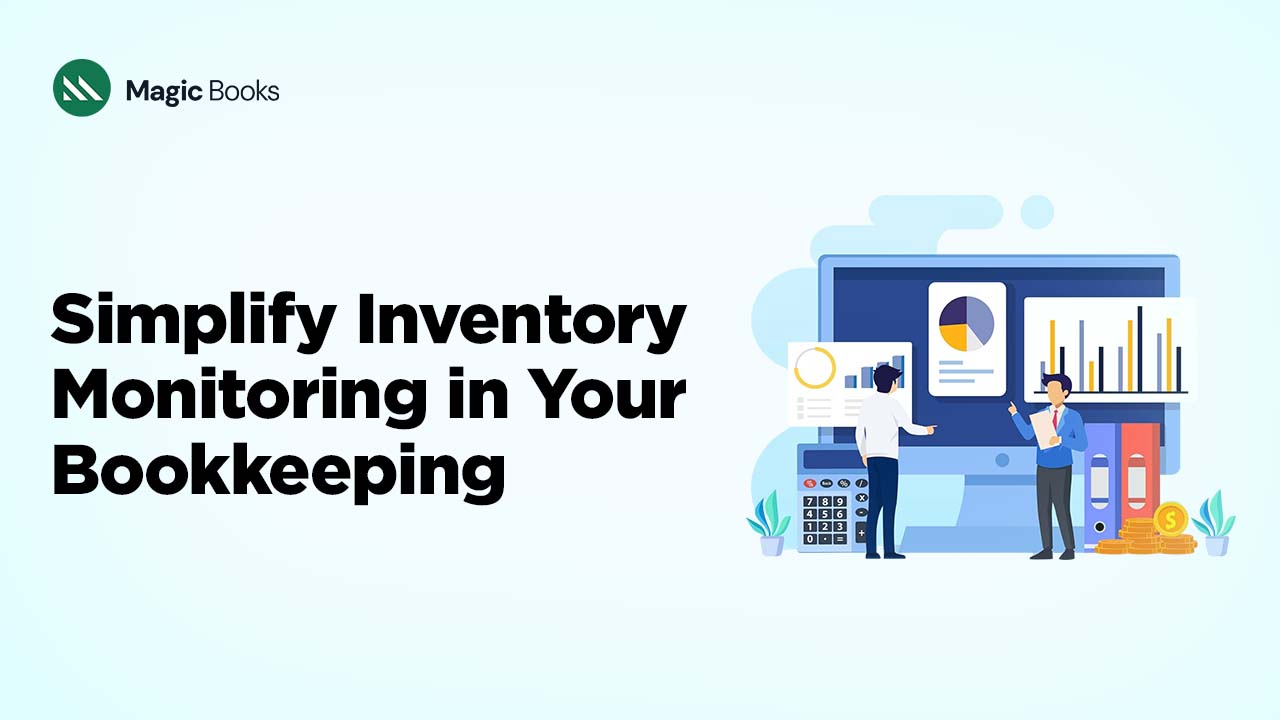Proper inventory management directly impacts any business’ bottom line more than many owners realise. According to industry research, businesses that implement systematic inventory tracking see up to 25% improvement in cash flow management and significantly reduced carrying cost. So, for financial advisors, bookkeepers and accountants serving clients with physical products, understanding inventory tracking with bookkeeping system is about unlocking better financial performance for every client you serve.
In 2025, stakes are higher than ever. When inventory tracking goes wrong, it throws off your cost of goods sold calculations, disrupts cash flow projections and reduces overall profitability. On the flip side, getting it right gives you precise control over financial reporting and enables smarter business decisions for sustained growth.
Why Accurate Inventory Tracking Matters
For most product based businesses, inventory represents their single largest investment. It can often account for 30% or more of total assets. When this tracking goes haywire, the problem cascades through every aspect of your financial reporting.
Think about what happens when you get your inventory number goes wrong. You overestimate what you have on hand and suddenly your cost of goods sold looks extremely low. Your profit margins also appear better than they actually are, which usually leads to poor business decisions based on misleading data. Underestimate your inventory and the opposite might occur. This means your cost seem inflated which makes your business appear less profitable than it really is.
The cash flow consequences hit even harder. When you tie up too much money in excess inventory, that capital sits on your shelves instead of working for your business. You are also paying for warehouse space, insurance and dealing with products that might eventually need to be marked down or written off entirely. On the flip side however, running too lean means turning away customers and missing sales because you simply don’t have what they want.
This balancing act becomes even more critical when you consider the tax implications and IRS doesn’t even give you much wiggle room here. They expect consistent inventory valuation methods and detailed documentation to back up your numbers. Your tracking system needs to stand up to scrutiny not just for operational purposes, but because accurate tax reporting depends on it. Getting this wrong can trigger audits and penalties that no business wants to face.
What are the Inventory Valuation Methods?
Setting up inventory tracking means making a crucial decision early on. This means how to assign costs as products move through business. There are 2 methods that are widely used in the industry:
- FIFO
- LIFO
The choice between them shapes everything from your tax bill to how attractive your company looks to potential investors.
The FIFO Method:
FIFO or First In First Out, operates exactly like it sounds. You are assuming that the oldest products in your warehouse get sold first. For most businesses, this mirrors reality pretty closely. If you are running a grocery store, you naturally rotate stock so the milk with the earliest expiration date moves first. Same principle applies whether you are selling electronics, clothings or industrial supplies.
FIFO gets really interesting from numbers perspective. When costs are rising, which happens more often than not, you are assigning those older cheaper purchases prices to your cost of goods sold. The newer, more expensive inventory stays on your books. As a result, ypru gross profits look stormier because you are matching current selling price against historical costs that were lower. Your balance sheet also shows higher inventory values, which can make your company appear more valuable.
The LIFO Methodology:
LIFO is the flip side of the coin. Last In First Out means you’re selling your newest inventory first, even though that rarely matches how products actually move through a business. Why would anyone choose this seemingly backwards method? The answer comes down to taxes and cash flow during inflationary periods.
When you use LIFO and costs are climbing, you’re assigning those recent, higher purchase costs to your cost of goods sold which drives up your reported expenses and drives down your taxable profits. Lower profits mean smaller tax bills, which means more cash stays in your business rather than going to the IRS. Some companies find this tax deferral advantage compelling enough to deal with the accounting complexity LIFO creates.
The choice between these methods creates dramatically different financial pictures of the same business. It’s pretty simple actually, during periods when suppliers are raising prices, FIFO companies report higher profits and pay more in taxes, while LIFO companies show lower profits but keep more cash on hand. Neither approach is inherently right or wrong, they are just different tools for different financial strategies.
Usually, many smaller businesses gravitate toward FIFO because it’s simpler to understand and explain. When your banker, investors, or even a potential buyer look at your financial statements, FIFO gives them a clearer picture of what’s actually happening operationally.
What Are the Key Inventory Metrics That Drive Decision Making?
Tracking inventory goes far beyond simply counting whats on your shelves. The real value comes from understanding the financial story your inventory tells through specific performance indicators. These metrics will tell you whether the inventory investment generates solid returns or quietly drains your resources.
- The Inventory turnover ratio:
This sits at the heart of this analysis. This number tells you how many times per year you completely sell through and replace your entire inventory. Calculate it by dividing your cost of goods sold by your average inventory value. Let’s take an example: Your annual costs of goods sold hits $500,000 and your average inventory value runs $100,000. Your turnover ratio comes out to 5.0, meaning you cycle through your entire inventory 5 times yearly.
What does this number mean for your business? Higher turnover ratio generally signals efficiency. It means you are converting inventory into sales revenue quickly rather than letting products sit around collecting dust. However, context matters enormously here. A grocery store might turn inventory 20-30 times per year because of perishable goods, while a furniture retailer might turn inventory just 4-6 times annually due to longer sales cycles and higher-priced items.
- Carrying Costs:
It represents the hidden expense that many business owners underestimate. These encompasses every dollar you spend holding inventory such as warehouse rent, insurance premiums, security systems, climate control and the opportunity cost of capital tied up in unsold goods.
How to Set Up Your Inventory Tracking System
The metrics that we mentioned above works best when viewed together rather than in isolation. A company with high turnover will look efficient but if you look closely they are constantly running out of popular items and losing sales. Let’s flip the coin. If there is low turnover, it might indicate overstocking but it could also mean you are successfully avoiding stockout in a business where customer satisfaction equals to immediate availability.
In such cases, setting up your inventory on an automated platform becomes absolutely necessary.
Getting your inventory system up and running doesn’t require a computer science degree but it does however demand attention to detail during the initial first setup. Most businesses today use platforms like QuickBooks and Magicbooks but the good news is these systems have streamlined the process considerably compared to the spreadsheet nightmares of years past. Let’s take it step by step:
- First step involves going to your software settings to activate inventory tracking capabilities. Once you flip that switch, the software unlocks all the tools you will need for comprehensive tracking
- Now comes the detailed work. Each product needs its own record containing essential details such as clear item names, unique SKU numbers, detailed descriptions, cost price and selling price. The SKU numbering system deserves particular attention here. Consistency in how you create these product codes pays dividends later when you are trying to track items across different sales channels or when you product one expands. A simple, logical and systematic approach prints confusion that inevitably leads to different teams making up their own numbering schemes.
- Your chart of accounts will need restructuring to accommodate inventory tracking properly. Most businesses require separate accounts for different inventory stages. Those stages, for example, might include raw materials if you have manufacturing products, work in progress for items currently being assembled and finished goods that are ready for sales. The specific accounts you need depend entirely on your business model but the key is to ensure these accounts integrate smoothly with your cost of goods sold calculations. This integration creates the audit trail that accountants love and the IRS expects.
- Setting realistic reorder points for each product requires some historical analysis and forward thinking. You will want to consider past sales patterns, how long suppliers typically take to fulfil orders and any seasonal fluctuations in demand. The best part is that modern bookkeeping platforms can automate much of this monitoring. All you have to do is set your threshold correctly and the system will alert you when the inventory levels drop to the point where reordering becomes necessary.
- The final step involves configuring the software for automatic quantity updates. Every time you record a sale or receive a purchase or make an adjustment, your system should automatically update inventory levels without requiring manual intervention. This becomes crucial for accurate month-end closes and management decision making.
How to Monitoring and Reporting for Better Decision Making
Once your inventory tracking system runs smoothly, the real value comes from the reports it generates. These numbers are the insights that can improve how you manage cash flow, pricing and purchasing decisions. Most bookkeeping platforms offer several types of inventory reports, each designed to answer different questions about your business performance.
- Monthly Inventory Aging: This deserves your immediate attention. These show exactly how long each item has been sitting on your shelves. This matters more than most business owners realize. For example: That widget you ordered six months ago might still look perfectly sellable, but it’s been tying up cash that could have been working elsewhere in your business. Items that age beyond normal sales cycles often need markdowns, promotional pushes, or other strategies to convert them back into cash before they become completely obsolete.
All this efforts become much more profitable when you have a solid inventory data backing up your projections. Let’s say those seasonal patterns you have been tracking suddenly become a powerful forecasting tool, you anticipate when you need extra capital or you can predict when slow seasons will free up cash that has been tied up in stock. Without this visibility, you might miss opportunities or worse, launch initiatives during periods when cash flow is already stretched thin.



